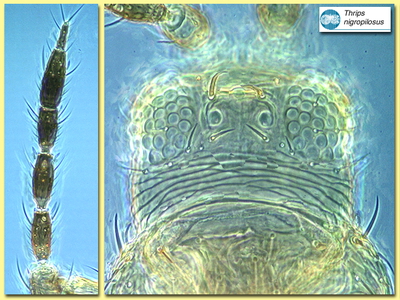Figures
Fig. 1 Antenna and head (dorsal)
Fig. 2 Long and short winged females
Fig. 3 Pronotum
Fig. 4 Short fore and hind wing
Fig. 5 Fore and hind wing
Fig. 6 Meso- and metanotum
Fig. 7 Pleurotergite II and III
Fig. 8 Tergite VI-VIII
Species
Thrips nigropilosus UzelBiology
Known as the Chrysanthemum thrips, this species has been a serious pest of cultivated Pyrethrum flowers in Kenya and of several other plants in other parts of the world.
Distribution
Widespread and locally abundant in temperate areas around the world.
Recognition
Small to medium sized thrips, usually yellow with brown markings, brown distal antennal segments, and pale forewings; micropterous individuals common. Antennae 7-segmented, sense cone on III & IV small and forked. Head with no setae in front of fore ocellus, one pair outside anterior margins of ocellar triangle. Pronotum with 2 pairs of posteroangular setae. Metanotum with variable sculpture, reticulate to elongate reticulate, median setae not near anterior margin. Forewing first vein with 3 setae on distal half. Tergite II with 3 lateral marginal setae; IV-VI with lines of sculpture between median setae, these setae particularly long in micropterae; V-VIII with ctenidia laterally, on VIII posteromesad of spiracle; posteromarginal comb on tergite VIII complete with slender microtrichia. Sternites and pleurotergites with no discal setae.
Related species
Amongst the 280 species of the genus Thrips, this species has most characters in common with the pest species T. tabaci and T. palmi.









